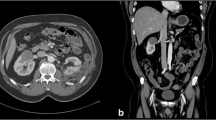Abstract
Objective
Irreversible electroporation (IRE) uses microsecond-long electric pulses to kill cells through membrane permeabilization, without affecting surrounding extracellular structures. We evaluated whether IRE can be used to induce urinary obstruction for a rat model of renal scarring.
Materials and methods
Intrasurgical IRE (2000 V/cm, 90 pulses, 100 μs) with caliper electrodes was performed in the right proximal ureter in male rats (n = 24) which were euthanized at 2, 5, or 10 days post-treatment, following contrast-enhanced magnetic resonance imaging. Complete urinary tract (bilateral kidneys, ureter and bladder) was extracted, and scored on a five-point scale for renal dilation, ureteral dilation and hydronephrosis. Whole kidney sections underwent immunohistochemistry to quantify levels of macrophages (CD68), activated fibroblasts [α-smooth muscle actin (α-SMA)], collagen (Masson’s Trichrome) and Hematoxylin and Eosin. Change in renal pelvis diameter and the number of glomeruli in the treated and contralateral urinary tract was also computed.
Results
Intrasurgical IRE performed with non-invasive caliper electrodes resulted in immediate loss of peristalsis in the treated ureteral segment, and cell death in the ureteral muscularis along with urothelial sloughing. Dilation of the ureter was observed on gross anatomic evaluation and histopathology. Magnetic resonance imaging indicated partial stricture and urinary obstruction in IRE-treated urinary tract, without evidence of urinoma, leakage or fistula formation. Enlargement of the kidney with progressive renal dilation and hydronephrosis was evident between Day 2 and Day 10 post-treatment. Obstructed kidney demonstrated scarring with elevated levels of tissue collagen, macrophages and α-SMA-positive fibroblasts. There was a steady decrease in the number of glomeruli in the obstructed kidney, while glomeruli numbers in the contralateral kidney remained unchanged through the 10-day observation period.
Conclusion
IRE provides a safe and reproducible technique to induce partial ureteral obstruction and renal fibrosis in rat model without the need for ligation or its associated complications.










Similar content being viewed by others
References
Romagnani P et al (2017) Chronic kidney disease. Nat Rev Dis Prim 3:17088
Thornhill BA, Burt LE, Chen C, Forbes MS, Chevalier RL (2005) Variable chronic partial ureteral obstruction in the neonatal rat: a new model of ureteropelvic junction obstruction. Kidney Int 67:42–52
Worcester EM, Coe FL (2008) Nephrolithiasis. Prim Care 35:369–391
Frokiaer J, Zeidel M (2011) Urinary tract obstruction. In: Skorecki K, Chertow G, Marsden P, Taal M, Yu A (eds) Brenner and Rector’s the kidney. Elsevier, Amsterdam
Chen GL, Bagley DH (2001) Ureteroscopic surgery for upper tract transitional-cell carcinoma: complications and management. J Endourol 15:399–404
Chevalier RL, Forbes MS, Thornhill BA (2009) Ureteral obstruction as a model of renal interstitial fibrosis and obstructive nephropathy. Kidney Int 75:1145–1152
Rubinsky B, Onik G, Mikus P (2007) Irreversible electroporation: a new ablation modality–clinical implications. Technol Cancer Res Treat 6:37–48
Srimathveeravalli G et al (2015) Feasibility of catheter-directed intraluminal irreversible electroporation of porcine ureter and acute outcomes in response to increasing energy delivery. J Vasc Interv Radiol 26:1059–1066
Srimathveeravalli G et al (2017) Normal porcine ureter retains lumen wall integrity but not patency following catheter-directed irreversible electroporation: imaging and histologic assessment over 28 days. J Vasc Interv Radiol. https://doi.org/10.1016/j.jvir.2017.02.032
Pech M et al (2011) Irreversible electroporation of renal cell carcinoma: a first-in-man phase I clinical study. Cardiovasc Intervent Radiol 34:132–138
Ruarus AH et al (2018) Irreversible electroporation in hepatopancreaticobiliary tumours. Can Assoc Radiol J 69:38–50
Dicker SE, Shirley DG (1972) Compensatory hypertrophy of the contralateral kidney after unilateral ureteral ligation. J Physiol 220:199–210
Paulson DF, Fraley EE (1973) Compensatory renal growth after unilateral ureteral obstruction. Kidney Int 4:22–27
Acknowledgements
We thank Mr. Dov Winkleman for his technical support in MRI of animals.
Funding
G.S. acknowledges the Society of Interventional Radiology Ernest Ring Academic Development grant for support of this work. The authors acknowledge the support of NIH Cancer Center Support Grant (P30 CA008748) for core laboratory services that were used for the presented work. The authors acknowledge the support of the Imaging Core Facility by NIH Small-Animal Imaging Research Program (SAIRP), R24 CA83084; NIH Center Grant, P30 CA08748; NIH Prostate SPORE, R24 CA83084. D.F received support from the Frederick J. and Theresa Dow Wallace Fund of the New York Community Trust.
Author information
Authors and Affiliations
Corresponding author
Ethics declarations
Conflict of interest
The authors report no relevant disclosures related to the work presented here. G.S. holds stock options in Aperture Medical. The authors declare no conflict of interest associated with this manuscript.
Translational statement
We present a preclinical model that captures the clinical presentation, progression and imaging appearance observed in patients demonstrating UUO due to iatrogenic injury, benign and malignant disease, and associated kidney injury and scarring.
Additional information
Publisher's Note
Springer Nature remains neutral with regard to jurisdictional claims in published maps and institutional affiliations.
Electronic supplementary material
Below is the link to the electronic supplementary material.
Change in peristalsis of the ureter following treatment with IRE. (A) Pre-IRE video shows normal peristaltic movement in both the right (to be treated) and left (control) ureters. (B) IRE treated ureteral segment (right, superior to the blood vessel) shows loss of peristalsis while normal motion can be observed in the segment inferior to the blood vessel. Peristaltic motion in the contralateral urinary tract is unremarkable (available at: https://doi.org/10.5281/zenodo.3624961) (MP4 5701 kb)
Supplementary material 2 (MP4 868 kb)
Rights and permissions
About this article
Cite this article
Vroomen, L.G.P.H., John, N.T., Fuijmori, M. et al. A new intrasurgical technique to safely and reproducibly induce partial unilateral urinary obstruction and renal scarring in a Rat Model. Int Urol Nephrol 52, 1209–1218 (2020). https://doi.org/10.1007/s11255-020-02421-1
Received:
Accepted:
Published:
Issue Date:
DOI: https://doi.org/10.1007/s11255-020-02421-1




